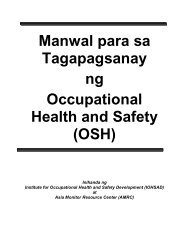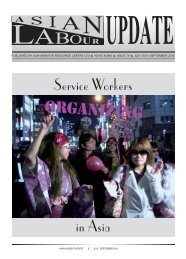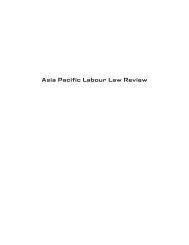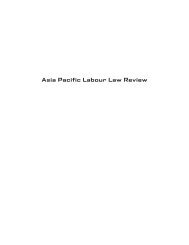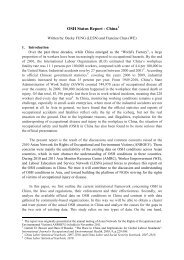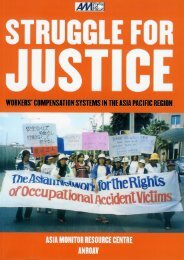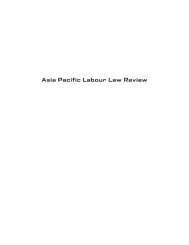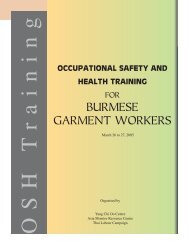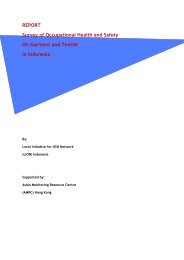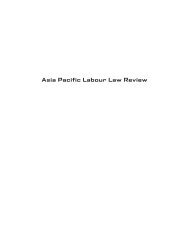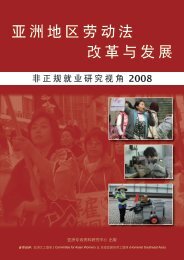Singapore - Asia Monitor Resource Center
Singapore - Asia Monitor Resource Center
Singapore - Asia Monitor Resource Center
You also want an ePaper? Increase the reach of your titles
YUMPU automatically turns print PDFs into web optimized ePapers that Google loves.
<strong>Asia</strong> Pacific Labour Law Review
<strong>Asia</strong> Pacific Labour Law ReviewWorkers’ Rightsfor the New Century<strong>Asia</strong> <strong>Monitor</strong> <strong>Resource</strong> Centre2003
<strong>Asia</strong> <strong>Monitor</strong> <strong>Resource</strong> Centre Ltd.AMRC is an independent non-governmental organisationthat focuses on <strong>Asia</strong>n and Pacific labour concerns.The <strong>Center</strong> provides information, research, publishing, training, labour networkingand related services to trade unions, pro-labour groups, and other development NGOs.AMRC’s main goal is to support democratic and independent labour movements in <strong>Asia</strong> and the Pacific.In order to achieve this goal, AMRC upholds the principlesof workers’ empowerment and gender consciousness, and follows a participatory framework.Published by<strong>Asia</strong> <strong>Monitor</strong> <strong>Resource</strong> Centre Ltd (AMRC), 444 Nathan Road, 8-B, Kowloon, Hong Kong, China SARTel: (852) 2332 1346 Fax: (852) 2385 5319 E-mail: admin@amrc.org.hk URL: www.amrc.org.hkCopyright © <strong>Asia</strong> <strong>Monitor</strong> <strong>Resource</strong> Centre Ltd, 2003ISBN 962-7145-18-1All rights reserved. No part of this publication may be reproduced, stored in a retrieval system, or transmittedin any form without prior written permission.Editorial TeamStephen Frost, Omana George, and Ed ShepherdLayoutTom FentonCover DesignEugene KuoAcknowledgementsAMRC expresses sincere thanks to the following people and organisations for their gratefully receivedcontributions to this book.Suchada Boonchoo (Pun) is co-ordinator for the <strong>Asia</strong>n Network for the Rights of Occupational AccidentVictims. We thank her for all the help in organising our conference of authors in Bangkok.Thanks to the American <strong>Center</strong> for International Labor Solidarity, Bangkok, Thailand for a financial contributiontowards printing the book.We are indebted to Oxfam Hong Kong for their financial contribution towards the production costs.Thanks to the International Labour Organisation for allowing us to use photographs from their library freeof charge.Eugene Kuo, a freelance photographer and designer, a big thank you for contributing photographs and designingthe cover free of charge. Look at www.226-design.com for some of Eugene’s stunning work andideas.To Tom Fenton, co-founder (with Mary Heffron) of AMRC – thanks a lot for advice, maps, and all the timedevoted to the layout of the book, free of charge. E-mail: tfenton@igc.org.Finally, we would like to thank the International Centre for Human Rights and Democratic Development,Canada, for an extremely generous contribution that covered much of the publishing costs of this book.Without their last-minute financial assistance, it is possible that this book would never have proceeded beyondthe editing stage. E-mail: ichrdd@ichrdd.ca; URL: www.ichrdd.ca.<strong>Asia</strong> <strong>Monitor</strong> <strong>Resource</strong> Centre
Labour Law and Workers’ Rightsin <strong>Singapore</strong> 1Stephen Frost and Catherine Chiu<strong>Singapore</strong> is one of the wealthiest countries in the region. Its workforce is well educated and its economy is nowunderpinned not only by manufacturing and trade but also by sectors in which knowledge and service are crucialelements. According to the Washington-based Heritage Foundation it is one of the world’s freest economies, andfor many commentators <strong>Singapore</strong>’s transformation over three decades has been nothing short of amazing.The labour laws under review in this chapter are founded on the remnants of colonial English common law,which has provided the basis for a comprehensive and sophisticated legal system. These laws, along with aunique tripartite relationship between government, business and unions, have led to an unprecedented 25 yearsduring which only a single strike has been recorded. With unemployment rates lower than many of its neighbours,high productivity levels, and relatively high wages, the tripartite systems seems to have delivered the best for allsectors. With the capacity to enforce regulations and small populations, <strong>Singapore</strong>’s labour law appears wellequipped to protect its labour force.1
Southeast <strong>Asia</strong>Political and legal structure<strong>Singapore</strong> has been self-governing since 1959 and fullyindependent since a political merger with Malaysiaended in 1965. It is a parliamentary democracy with aunicameral parliament of 84 members. Currently, thePeople’s Action Party (PAP), which has won every generalelection since 1959, holds 82 parliamentary seats(97.6 percent). The PAP won 73.5 percent of the vote inthe last national elections held in November 2001. Themain opposition parties are the Workers’ Party, <strong>Singapore</strong>Democratic Alliance, <strong>Singapore</strong> Democratic Party,and the Democratic Progressive Party. The next electionsare due in early 2007.Fourteen ministries oversee government administration.The principal office responsible for labour relationsand regulations is the Ministry of Manpower. The Ministry’sprimary mission ‘is to develop a globally-competitiveworkforce to support <strong>Singapore</strong>’s vision of aknowledge-based economy’ for which five ‘businessgroups’ assume responsibility: Planning, Development,Augmentation, Environment and Welfare, and CorporateSupport. 2 The business group for environment andwelfare oversees labour relations, occupational healthand safety (OHS), and work injury compensation. Thecurrent Minister for Manpower is Dr Lee Boon Yangwho has held the portfolio for labour or manpower since1992.<strong>Singapore</strong> derives its legal system from English commonlaw and comprises the Constitution, legislation,and subsidiary legislation. The Constitution enshrinesfundamental rights, Parliament passes laws through legislation,and ministers or other authorised persons orbodies pass rules and regulations referred to as subsidiarylegislation.Judicial power is vested in the Supreme Court and itssubordinates. The Constitution safeguards the independenceof the judiciary. The Supreme Court consists of aHigh Court and a Court of Appeal. Since the JudicialAppeal (Review) Bill of 1994 abolished all appeals tothe Privy Council (a court of final appeal in the UK formembers of the Commonwealth), the Court of Appealhas become <strong>Singapore</strong>’s final court of law.The Arbitration Court, which is examined below, isthe principal institution in which labour disputes are resolved.The Minister of Manpower may in some casesuse his discretion to force arbitration upon parties in disputeif he believes that the public interest is jeopardised. 3The Employment Act 1968 (EA) is the primary statutegoverning employment in <strong>Singapore</strong>. Other relevantlaws are the Industrial Relations Act, the Trade UnionsAct, and the Factories Act. In brief, the EA sets out the‘general terms and conditions of employment and thebasic rights and duties of employers and employees’. 4 Inthe hierarchy of <strong>Singapore</strong>’s laws, labour laws and regulationsdo not feature prominently. This is primarily dueto tripartism where the government, trade unions, andemployers come together to resolve issues relating to labourand employment prior to coming before the courtsas a legal matter.Labour force structureAs of June 2001, <strong>Singapore</strong>’s labour force stood at 2.12million, a 27 percent increase over the last decade, out ofa total population of 4.02 million (SDS 2001: 2). 5 Keyfindings of the 2001 annual survey of the labour forceare:• female participation in the labour force was 54percent, up two percent over the decade;• although overall educational attainment levelshave risen due to new entrants, approximately 33percent of the work force still does not have secondaryqualifications;• the work force is older, with the median age rising4.2 years to 37.8 over the last decade;• thirty-three percent of workers had undertakensome form of training over the 12 months endingJune 2001, much of it skewed towards higher educationalattainment;• employment has shifted from the manufacturingsector to services (MOM 2001: ix);• the unemployment rate was 3.4 percent (72,900persons), a 78.95 percent rise over the course ofthe decade. 6<strong>Singapore</strong>’s industrial composition has changed overthe past decade. Whereas the manufacturing sector wasonce dominant, financial and business services alongwith community and personal services have grown significantly.This is in line with the prevailing trend towardsa knowledge-based economy. There are a total of8,970 enterprises comprising 25 persons or above, the2 <strong>Asia</strong> <strong>Monitor</strong> <strong>Resource</strong> Centre
SINGAPOREgreat majority (75.5 percent) work in workplaces of lessthan 100 persons. Only eight percent of workers are employedin establishments with 250 employees or more.Professionals and managers, technicians and associateprofessionals have grown as a proportion of theworkforce, 69.8 and 45.6 percent respectively.For the first time, the 2001 survey collected data onnon-standard forms of work and noted that 83,600 workers(4.2 percent) were casual or on-call workers, freelancers,or temporary help agency workers. 7It should be noted with regard to working hours thatalthough the average hours worked per week was 49.8,several sectors worked much longer. Cleaners, labourers,and related workers for instance, worked on average59 hours per week, with females in this category averaging63.5 hours. 8 Clerical workers clocked in for an average44 hours per week. 9The labour lawEmployment in <strong>Singapore</strong> is governed by the EA, whichcame into operation on 15 August 1968. Prior to the enactmentof the EA, three ordinances regulated the conditionsof service for employees:• The Labour Ordinance 1955;• The Shop Assistant Ordinance 1957;• The Clerks Employment Ordinance 1957.With the enactment of the EA, the government repealedall three ordinances from the 1950s. The EA wasenacted to standardise the working conditions for all employeesin <strong>Singapore</strong>, with the exceptions noted below.The implementation of the EA in the 1960s should beunderstood in the context of high (around nine percent)unemployment and a wave of strikes motivated by economicand political issues, the government’s strategy ofencouraging private sector-led industrialisation and theneed to attract foreign capital, and the necessity – fromthe government’s perspective – of controlling labourcosts. 10 To ensure <strong>Singapore</strong>’s competitiveness, the PAPblunted the power of independent labour and strengthenedthe PAP-affiliated National Trades Union Congress(NTUC). The PAP introduced the EA to reduce wages,erode conditions, increase working hours, and limit bargainingpowers and the ability to take industrial action. 11This strategy has been so successful that <strong>Singapore</strong> haswitnessed only one strike since 1978.As detailed in following sections, the EA is supplementedwith other legislation, such as the Employment(Part-time Employees) Regulations, the Workmen’sCompensation Act, the Central Provident Fund Act, theIndustrial Relations Act, the Trade Union Act, TheTrade Disputes Act, the Retirement Age Act, the FactoriesAct, and the Employment of Foreign Workers Act.Coverage and exclusionsThe EA sets out the general terms and conditions of employmentand the basic rights and duties of employeesand employers. It consists of sixteen parts. Coverage bythis act and other laws is to a large degree dependent onhow the law defines an employee.An ‘employee’ under the EA is defined as: ‘A personwho has entered into or works under a contract of servicewith an employer and include a workman and any officeror servant of the Government included in a category,class or description of such officers or servants declaredby the President to be employees for the purposes of [theAct … or section thereof] but does not include any seaman,domestic servant, watchman or security guard orany person employed in a managerial, executive or confidentialposition or any person belonging to any otherclass of persons whom the Minister may from time totime by notification in the Gazette, declare not to be employeesfor the purposes of this Act. The Act applies toemployees who are foreigners too so long as they fallwithin the definition of employees under the Act.’The term ‘employer’ covers any person who employsanother person under a contract of service, which includesthe government. It also includes any statutory authority,or a duly authorised agent or manager of theemployer, and any person who owns or is carrying on oris for the relevant period responsible for the managementof the profession, business, trade, or work in whichthe employee is engaged.The employer and employee are free to agree to theinclusion of whatever terms in the contract of servicethey wish. However, every term of a contract of servicethat provides a condition of service less favourable to theemployee than that prescribed by the EA is illegal, nulland void.The key point to note here is that the EA does notcover all workers in <strong>Singapore</strong>, in particular managers,domestic workers, security guards, seaman, and any per-<strong>Asia</strong> Pacific Labour Law Review 3
Southeast <strong>Asia</strong>son employed by a Statutory Board or by theGovernment.However, even if a worker is defined as an employeeunder the EA, some aspects of the law may not be applicable.For example, a range of provisions are applicableonly to employees who are in receipt of salaries not exceedingSG$1,600 per month (a figure that the Ministerof Manpower may vary). Other provisions apply only to‘workman’ (defined as ‘any person, skilled or unskilled,doing manual work, including any artisan or apprenticebut excluding any seaman or domestic servant; any personother than clerical staff …, any person specified inthe First Schedule of the EA, namely, bus conductors,lorry attendant, tailors, all workmen employed on piecerates in the premises of the employer’, and so on).Thus, clerical workers (who are not defined as ‘workmen’)earning more than SG$1,600 per month are notentitled to claim overtime payments because the relevantsection of the Act (Part IV) only covers ‘workmen’.12 Likewise, Maternity Protection & Benefitsapply only to women.These definitions of employees and workmen haveimportant implications for other pieces of legislationtoo. For instance, the Workmen’s Compensation Actprovides for ‘workmen’ who are injured or afflictedwith occupational diseases in the course of their work,and the protection of the right to be compensated. However,these provisions apply only to ‘workmen’. Thus,the following persons cannot claim worker’scompensation:• non-manual worker who earns more thanSG$1,600 a month;• casual worker whose work is not connected withthe employer’s trade or business;• domestic servant;• police officer;• person who works with material supplied by anotherperson but without any supervision in his/herown home;• any member of the employer’s family living in thehome of the employer;• any class of persons excluded by the Minister.A contract of service under the EA is ‘an agreementby one person to hire another person to do work. Thecontract may be in writing, oral, express, or implied. Itincludes an apprenticeship contract or agreement’. 13DismissalEither the employer or the employee has the right to enda contract of service. Formal notice need not be providedby either party. If given, however, the notice must be inwriting. The period of notice provided by either partyshould be in accordance with the contract of service. Ifthe length of employment period was not stipulated inthe contract, then the following shall apply:Length of employmentPeriod of noticeLess than 26 weeksone day26 weeks to less than two years one weektwo years to less than five years two weeksfive years and morefour weeksEither party has the right to terminate a contract withoutnotice. However, should they do so, they are legallyrequired to pay the other party a sum equal to the amountof salary that would have been earned by the employeeduring the required period of notice. Subject to mutualagreement, either party may waive their right of notice.An employer may dismiss an employee without noticeon the grounds of misconduct that contravenes the conditionsof employment, but they cannot dismiss a femaleemployee during her maternity leave except under expressconditions. An employee may stop working for anemployer without notice if the employee is asked to dowork that involves danger, risk of disease, and thatwhich is not within the terms of the contract.Discrimination<strong>Singapore</strong> has no laws that prevent employers discriminatingon the basis of race. <strong>Singapore</strong> law does, however,have a number of provisions that either preventdiscrimination in specific sectors or are discriminatoryin their nature; namely in the areas of compensation,central provident fund contributions, retirement, and terminationof employment.Section 80 of the Industrial Relations Act providesthat employers cannot discriminate against members oftrade unions. An employer cannot refuse to hire a newemployee if s/he is or intends to be an officer or a memberof a trade union. Similarly, an employer or any otherperson cannot persuade his employees or other personsnot to be officers or members of a union or to form a union.In fact, an employer must, on application of an em-4 <strong>Asia</strong> <strong>Monitor</strong> <strong>Resource</strong> Centre
SINGAPOREployee, grant leave with or without pay to enable the employeeto do trade union work.The minimum wage<strong>Singapore</strong> has no minimum wage law, and salaries aresubject to negotiation between the employee or the tradeunion representing employees and the employer.Hours of work, overtime,holidays, and leaveSection 2 of the EA defines ‘hours of work’ as a periodof time during which an employee is expected to carryout the duties assigned by the employer. 14 It excludesany intervals allowed for rest and meals.In general, employees are not required to work morethan eight hours a day or 44 hours a week. If the contractof service stipulates that the number of hours on one ormore days of the week is less than eight, then the limit ofeight hours may be exceeded on the remaining days ofthe week. For employees on a five-day week, the limit ofeight hours a day may also be exceeded but they shall notbe required to work more than nine hours a day or 44hours a week.In practice many employees work longer hours, withfemale cleaners averaging 63.5 hours.Employees are entitled to 11 paid public holidayseach year as listed in the EA. They are also entitled to annualleave consisting of seven working days for the firstyear of service, and an extra day of annual leave for everysubsequent 12 months of continuous service subjectto a maximum of 14 days. Annual leave does not includeany rest day, public holiday or sick leave to which theemployee is entitled.Employees who have worked for 12 months are entitledto 14 days of paid sick leave per year if no hospitalisationis needed. The 14 days can be extended up to 60days if hospitalisation is needed. The EA enables an employeeto be certified ill enough to be hospitalised withouthaving to be actually warded in a hospital. To obtainsick leave an employee must be examined by a doctorappointed by the employer, or if none has been appointed,by a government doctor. The employee must informor try to inform the employer within 48 hoursotherwise the worker is deemed to be absent from workwithout reasonable excuse. If the employee has workedfor the same employer for at least six months, the latter islegally obliged to pay the medical examination fee. Asfor other medical costs such as medication, treatment, orward charges, the employer’s obligation depends on themedical benefits provided in the employment contract.A female employee is entitled to four weeks of maternityleave before confinement and four weeks after confinement.By agreement with the employer, she can takeshorter pre-confinement and longer post-confinementleave to allow more time to recuperate and to be with thebaby.Special provisions for childrenand migrant workersLabour laws provide for special working conditions forchildren and foreign workers.Part VIII of the EA governs the employment of childrenand young persons. The EA defines a child as a personunder 14 years of age, and a young person above 14but below 16 years of age. No child under 12 can beemployed.Even though children can be employed, there arestrict guidelines concerning the type of work in whichchildren and young persons may engage. Employersmay only engage children aged 12 years or above in lightwork suited to their capacity. They shall not be employedin any industrial undertaking or any vessel unlesssuch undertaking or vessel is under the personal chargeof a parent. Young persons (aged 14 years or above butunder 16 years) may be employed in industrial undertakings,but employers are required to notify the Commissionerfor Labour within 30 days of employing a youngperson attaching a medical certificate certifying their fitnessfor employment.The Employment of Foreign Workers Act is designedto control the employment of foreign workers, and definesforeign workers as ‘any person who is not a citizenof <strong>Singapore</strong> who seeks employment with, or is offeredemployment by, an employer at a salary of not more thanSG$1,500 a month or such other sum as may, from timeto time, be fixed by the Minister by notification in theGazette’. All foreign workers must obtain work passesto work. It is a serious offence for any foreign worker towork, or for any employer to employ a foreign worker,without a work pass.A work pass is a permit issued by the Ministry ofManpower to allow a foreign worker to work. It is valid<strong>Asia</strong> Pacific Labour Law Review 5
Southeast <strong>Asia</strong>only for the occupation it is issued for, the employer, thespecified worker and for the stated period. A police officeror an employment inspector may arrest any personwho is working without a work pass. Section 13 of theAct stipulates that foreign workers must produce theirpass for inspection whenever necessary, and return thework pass through the employer to the Ministry withinseven days of stopping work.The Government amended the Immigration Act in1995 in an attempt to curtail employers hiring foreignworkers resident in the country illegally. Due to variousmeasures designed to regulate their employment, suchas requiring employers to pay a levy for every foreignworker, and the implementation of a dependency ratiothat is adjusted periodically to reflect the supply and demandin the labour market, many employers had resortedto hiring non-registered foreigners, particularly inthe construction industry. 15 The amendments include thefollowing provisions:• contractors are now responsible for illegal workersfound residing or working on worksites. Unlikethe situation previously, they can no longer passthe responsibility to sub-contractors by denyingknowledge of the workers’ immigration status;• the onus of proof with regard to the immigrationstatus of workers is now resides solely with theemployer. Prosecutors are no longer required toprove that employers knew their employees wereillegal immigrants. In the past, prosecutions oftenfailed because employers were able to claim thatthey did not know employees were illegal immigrants;• employers of illegal workers are subject to heavyfines. Repeated offenders may even be jailed orcaned. 16Legal status of unionsThe period between the end of the Second World Warand the formation of <strong>Singapore</strong> as an independent sovereignstate in 1965 was marked by a struggle for controlof <strong>Singapore</strong>’s trade union movement. 17 Militant andpoliticised trade union activity was effectively bluntedwith the formal registration of the NTUC in 1964. Duringthe 1960s and 70s, the NTUC has worked at developingclose relations with the PAP and business to forma tripartite partnership that now oversee (but do not necessarilyprotect) the interests of workers. As stated byLim Boon Heng (the Secretary-General of the NTUC),“Ours is a value-adding labour movement. We add valueto workers by protecting their interests and providingthem with many benefits. We add value to business byfostering industrial harmony and encouraging workersto upgrade their skills and become more productive. Weadd value to society by stabilising prices through ournetwork of co-operatives and by making available qualitysocial and recreational facilities to <strong>Singapore</strong>ans atprices they can afford (Lim 2002b).” 18Under <strong>Singapore</strong> law, the status of trade unions is administeredby the Industrial Relations Act and the TradeUnion Act. The law controls industrial action by way ofthe Trade Disputes Act, which is covered below.The Industrial Relations Act regulates relations betweenemployers and employees and provides the legalframework to prevent and settle trade disputes by collectivebargaining, conciliation, and arbitration. Industrialrelations between parties are regulated in order to maintainindustrial peace.In general, a trade union is legally able to representany employee. However, the Minister has the right to declarepersons not to be employees, and they are thus accordinglygazetted as such under the Act and unions donot have the right to represent such persons. Further, unionsdo not have the right to represent employees if,upon appointment or promotion as a manager or an executive,they have agreed not to be or not to continue tobe an officer or member of a particular trade union thatdoes not organise and represent only managerial or executiveemployees.Employers have the right to refuse recognition of atrade union on the grounds that it does not represent themajority of employees, or if there is more than one tradeunion claiming to represent the same group of employees.In such cases, the Commissioner will conduct a secretballot to settle the matter. They can also legallyrefuse to recognise a union on the grounds that employeesare not able to be members of a particular union. Ifso, the dispute is settled by making a joint application tothe Industrial Arbitration Court (IAC).The Trade Union Act provides for the registrationand control of trade unions in <strong>Singapore</strong>. It stipulateswho can form or join a union, and spells out the rights,immunities and privileges of a union, as well as limita-6 <strong>Asia</strong> <strong>Monitor</strong> <strong>Resource</strong> Centre
SINGAPOREtion. The Act also regulates the use of union funds. Thelatest definition and amendments to the Trade Union Actappear to stress the NTUC’s role, which has evolvedfrom solely acting as a bargaining agent on behalf ofworkers to a social partner in nation-building.Under the Act, trade unions can be deregistered for anumber of reasons, among them misuse of funds, a beliefthat the trade union may be used against the interestsof workers (who determines this is unclear), or thatworkers can be better represented by another trade union(who determines this is unclear).Union formation andmembership coverageForming and joining a trade union is legally sanctionedin <strong>Singapore</strong>, and takes only seven members to applyand register a new union. Union density stands at about14.8 percent. The number of overall employee trade unionshas fallen during the last decade (from 83 to 71), butmembership numbers have increased significantly (an increaseof around 121,000 members to a total of 338,311,or an increase of 35.8 percent), bucking the general <strong>Asia</strong>nand global trend. Sixty-five of all trade unions (91.5 percent)belong to the NTUC. Trade unions with more than10,000 members have more than doubled over the decadefrom 1991, at the expense of smaller unions, most ofwhich have declined significantly.Roles and function of unionsTrade unions in <strong>Singapore</strong> are one of three legs of a tripartitesystem of industrial relations. As outlined in theTrade Unions Act, the trade union movement’s majorrole is to promote good industrial relations, improveworking conditions, and raise productivity.These functions are very different to the narrowly definedand traditional objectives in the 1970s. The tradeunion movement now sees its role as working in partnershipwith employers and government. It is also heavilyinvolved in social, educational, and recreational activities.The NTUC provides job search assistance, training,skills development, programmes to increase productivityand workplace health (or what they call ‘’), ownershipand management of FairPrice (one of <strong>Singapore</strong>’sleading supermarket chains with over 100 stores islandwide). In their social role, unions now own and managechildcare centres, clubs, and holiday bungalows.Collective agreementsCollective bargaining takes place at the enterprise level.Trade unions can represent workers, but they are barredfrom negotiating such issues as ‘promotion, transfer, newhiring, assignment of duties of employees, dismissal, retrenchment,and reinstatement’. 19 Most agreements arefor two years. Although most are arrived at through negotiationand conciliation, irreconcilable disputes are resolvedby the IAC, which determines awards on thoseissues where the parties cannot reach agreement.2001 saw a total of 407 collective agreements, ofwhich 398 were in the private sector and the remainingnine from statutory boards. No government workers arecurrently covered by collective agreements.Because collective agreements are negotiated on thebasis of individual enterprises, the 407 agreements extantin 2001 account for only a small proportion of workers.For instance, although there were 398 agreements inforce in the private sector in 2001, they accounted foronly 4.53 percent of all private enterprises and coveredthe interests of 44,465 employees who were union members.All 407 agreements covered 54,830 workers. 20Employer organisationsIt is worth noting briefly the important role played byemployer organisations in <strong>Singapore</strong>. Under the tripartitesystem, such organisations play a crucial role in determiningthe industrial relations landscape. The currentpeak body representing employers – the <strong>Singapore</strong> NationalEmployers Federation (SNEF) has around 1,800members and is registered as a trade union under theTrades Unions Act. It is, in effect, the national trade unionof employers and is thus ‘the counterpart to theNTUC’. SNEF sits with the NTUC on a variety of tripartedbodies such as the National Wages Council andthe National Productivity Board. Just like the NTUC,SNEF is entitled to select panel members for the IAC.Other bodies also represent business in differentways, such as the <strong>Singapore</strong> International Chamber ofCommerce (SICC), and the <strong>Singapore</strong> Confederation ofIndustries (SCI). In 2001, membership of employers’trade unions stood at 1,971.Strikes and lockoutsIndustrial action is regulated through the Trade DisputesAct, the purpose of which is to control trade disputes,<strong>Asia</strong> Pacific Labour Law Review 7
Southeast <strong>Asia</strong>strikes, lockouts, and picketing. The Act defines industrialaction as illegal if it:• supports a trade dispute that does not involve thestriking workers or the lockout by employers;• supports a trade dispute that has been duly submittedto the IAC;• intends to put pressure on the government, eitherdirectly or by making life difficult for the community.21This does not mean there are no disputes; there are.However, for 25 years, <strong>Singapore</strong> has only witnessed asingle strike involving 61 workers and the loss of 122workdays. To provide some context, the previous 25years saw 842 stoppages, involving 207,109 workers,and the loss of 3.144 million workdays. 22Dispute resolutionAlthough strikes have been reduced to nil, disputes betweenmanagement and employees are not uncommon(though they are few in number). Dispute resolution in<strong>Singapore</strong> is achieved through mediation, conciliation,or arbitration. The first two stages are managed by theMinistry of Manpower through its Labour Relations Division.Upon receiving notice of an employee-employerdispute it seeks to mediate and conciliate. If these optionsfail to resolve the conflict, then the parties can applyto the IAC, whose decisions are final. 23The main causes for disputes are overwhelmingly theissues of wages, benefits and bonuses. Although disputesreferred to the IAC have fallen over the decade,there has been a 53.3 percent rise from 2000 to 2001.However, 2001 saw only 23 cases presented to the IAC.Disputes referred for conciliation (that is, to be resolvedthrough the Ministry of Manpower) rose 15.2 percentfrom 2000 to 2001, but the number of claims was smalland stood at 266. Despite this, complaints about retrenchmentshave witnessed a significant increase, ashave complaints originating in the construction, commercial,and financial sectors. Claims by individualsover matters requiring resolution by the Ministry ofManpower Disputes Section are significantly more innumber than any other disputes, and in 2001 numbered11,561. There was a 65.3 percent rise in these claims between2000 and 2001 alone, but the rise over the entiredecade was 355.2 percent. Fifty-nine percent of allclaims involve disputes over wages.Occupational health and safety,the Labour Inspectorate,and the DutiesOccupational health and safety (OHS) in the workplaceis administered by the Factories Act, which pertains toall matters relating to the health, safety, and welfare ofpersons employed in factories and other workplaces. At2001 year’s end, 16,693 factories/workplaces were registeredwith the Ministry of Manpower. Registered factories/workplacesmust comply with the Act, whichprovides standards and provisions for:• health requirements cleanliness, overcrowding,and ventilation;• machinery guarding - guards and fencing, andskilled operators;• electrical safety - well constructed, safe, and wellmaintained;• lockout procedures - to isolate energy sources formachine maintenance• provisions for a safe workplace - covers, obstructions,and safe means of access;• work in a confined space - adequate ventilation,and safe work procedures;• explosion prevention - gas, vapours, and flammablematerials;• fire prevention - extinguishers, exits, and fire drills;• safe work procedures - hazard identification;• lifting equipment - tests for hoists and lifting appliances;• pressure vessels/gas plants - tests for boilers andrefrigeration plants;• personal protective equipment - approved coveringsfor specific tasks;• elfare - drinking water, first aid, and washing facilities;• toxic substances - competent handling of and preventativemeasures;• material safety data sheet - made available, used;• medical examinations - compulsory medical examinationsfor those using specific substances;• reporting of accidents and diseases - all industrialaccidents (death, disablement for three days, andhospitalisation for 24 hours) reported;• safety officers - full time or part time, dependingon workplace;8 <strong>Asia</strong> <strong>Monitor</strong> <strong>Resource</strong> Centre
SINGAPORE• safety committees - workplaces with more than 50workers should have one;• record keeping - keep all records for five years forinspectors;• penalties - for contraventions of the Act.The Labour Inspectorate is responsible for ensuringthe provisions in the Factory Act are relevant to changeswithin specific sectors, inspecting factories, inspectingand testing hazardous equipment, investigating accidents,certifying competent persons such as safety officersand factory doctors, and training and promotion inOHS.A factory inspector can enter a factory at any time toinspect the premises and to question an employer or theoccupier of the factory. The Chief Inspector can requirean employer or the occupier of a factory to make alterationsto premises before registering or renewing registrationof the factory under the Act. OHS inspectionshave increased 89.4 percent since 1996 to 14,286 inspectionsin 2000.Government statistics on industrial accidents showthat <strong>Singapore</strong>an employees are working in safer environmentsthan a decade ago. However, there are severalcases that go against this positive trend. Of particularnote is the overall increase in the degree of incapacity resultingfrom accidents in the construction industry Severityrates in the service industries have also increasedmarkedly.ConclusionThe distinguishing feature of <strong>Singapore</strong>an labour relationsand regulation is a tripartite system that has delivereda level of workplace harmony not seen elsewhere.The PAP has been able to successfully implement itsstrategies in consultation with the assistance of theNTUC and business/employer groups, all of who sharethe goals of industrial harmony, increased productivity,and economic development. This had provided workerswith increasing levels of safety and living standards overthe last two decades, but has solidified the positions ofthe state and its supporters perhaps to the detriment ofworkers’ ability to respond to changes wrought by theglobal economy.Notes1. The authors gratefully acknowledge funding fromSEARC Project No XX. A more detailed version of thispaper was published as a SEARC Working Paper in December2002. See Stephen Frost and Catherine Chiu,‘Labour Relations and Regulations in <strong>Singapore</strong>: Theoryand Practice’, City University of Hong Kong, Southeast<strong>Asia</strong> Research Centre Working Paper No. XX (HongKong: SEARC, 2002), at: http://www.cityu.edu.hk/searc/WP.html2. ‘About MOM’, (Ministry of Manpower, 2002), athttp://www.gov.sg/mom/menubar/aboutmom/abmom.htm3. C H Tan, ‘Employment Relations in <strong>Singapore</strong>, 2 ndEdition’ (<strong>Singapore</strong>: Prentice Hall, 1999, p. 28).4. Ibid., (p. 167).5. Ministry of Manpower, ‘Report on Labour Force in<strong>Singapore</strong>, 2001’, (<strong>Singapore</strong>: Ministry of Manpower,2002, p. ix), at http://www.gov.sg/mom/manpower/manrs/manrs.htm; <strong>Singapore</strong> Department of Statistics, ‘<strong>Singapore</strong>Population, 2000’, (<strong>Singapore</strong>: <strong>Singapore</strong> Departmentof Statistics, 2001, p. 2).6. Ministry of Manpower, ‘Report on Labour Force in<strong>Singapore</strong>, 2001’, Table 1. (<strong>Singapore</strong>: Ministry of Manpower,2002).7. Ibid., (p. 21).8. Ibid., (p. 26).9. Ibid., (p. 25).10. Garry Rodan, ‘<strong>Singapore</strong>: Globalisation and thepolitics of economic restructuring’, in Rodan, G., Hewison,K. and Robison, R. (eds.), The Political Economyof South-East <strong>Asia</strong>: Conflicts, Crises and Change, 2 ndEdition, (Melbourne and New York: Oxford UniversityPress, 2001, pp. 144-145); Soon Beng Chew and RosalindChew, ‘Employment-Driven Industrial RelationsRegimes: The <strong>Singapore</strong> Experience’, (London: Avebury,1995, p. 117).11. Garry Rodan, ‘<strong>Singapore</strong>: Globalisation and thepolitics of economic restructuring’, in Rodan, G., Hewison,K. and Robison, R. (eds.), The Political Economy ofSouth-East <strong>Asia</strong>: Conflicts, Crises and Change, 2 nd Edition,(Melbourne and New York: Oxford UniversityPress, 2001, p. 145.12. Ministry of Manpower, ‘Coverage of the EmploymentAct’, (Ministry of Manpower, 2002), at http://www.mom.gov.sg/wpeaw/labfile/labr9a.htm13. C H Tan, ‘Employment Relations in <strong>Singapore</strong>’, (p.169).14. Ibid., (pp. 173-182).15. Ibid., (p. 201).16. Ibid.17. C Leggett, ‘Corporatist trade unionism in <strong>Singapore</strong>,’in Frenkel, S. (ed.), Organized Labor in the<strong>Asia</strong> Pacific Labour Law Review 9
Southeast <strong>Asia</strong><strong>Asia</strong>-Pacific Region: A Comparative Study of TradeUnionism in Nine Countries, (Ithaca: ILR Press, 1993,pp. 224-225).18. Lim Boon Heng, ‘Our message: Adding value,’(NTUC Online: The Union, 2002), at http://www.ntucworld.org.sg/myunion/aboutus/aboutus.html19. Basu Sharma, ‘Industrial Relations in ASEAN: AComparative Study’, (Fredericton, New Brunswick: ManagementFutures, 1996, p. 82).20. Industrial Arbitration Court, ‘Annual Report of thePresident: Industrial Arbitration Court, 2001’, (<strong>Singapore</strong>:IAC, 2001, p. 13), at http://www.iac.gov.sg/Annual_Report/Annual_Report_2001.doc21. C H Tan, ‘Employment Relations in <strong>Singapore</strong>’, (p.190).22. ‘Ministry of Manpower Yearbook’, various years,andCHTan,‘Employment Relations in <strong>Singapore</strong>’, (p.221).23. Basu Sharma, ‘Industrial Relations in ASEAN: AComparative Study’, (Fredericton, New Brunswick: ManagementFutures, 1996, p. 85).10 <strong>Asia</strong> <strong>Monitor</strong> <strong>Resource</strong> Centre
SINGAPOREAppendixConformity with international law<strong>Singapore</strong> has been a member of the International LabourOrganisation (ILO) since 1965 and has ratified 23conventions as follows:Convention No. 5 on Minimum Age (Industry) 1919,ratified 25 October 1965;Convention No. 7 on Minimum Age (Sea) 1920, ratified25 October 1965;Convention No. 8 on Unemployment Indemnity (Shipwreck)1920, ratified 25 October 1965;Convention No. 11 on Right of Association (Agriculture)1921, ratified 25 October 1965;Convention No. 12 on Workmen’s Compensation (Agriculture)1921, ratified 25 October 1965;Convention No. 15 on Minimum Age (Trimmers andStokers) 1921, ratified 25 October 1965;Convention No. 16 on Medical Examination of YoungPersons (Sea) 1921, ratified 25 October 1965;Convention No. 19 on Equality of Treatment (AccidentCompensation) 1925, ratified 25 October 1965;Convention No. 22 on Seamen’s Articles of Agreement1926, ratified 25 October 1965;Convention No. 29 on Forced Labour 1930, ratified 25October 1965;Convention No. 32 on Protection against Accidents(Dockers) (Revised) 1932, ratified 25 October 1965;Convention No. 45 on Underground Work (Women)1935, ratified 25 October 1965;Convention No. 50 on Recruiting of IndigenousWorkers 1936, ratified 25 October 1965;Convention No. 64 on Contracts of Employment (IndigenousWorkers) 1939, ratified 25 October 1965;Convention No. 65 on Penal Sanctions (IndigenousWorkers) 1939, ratified 25 October 1965;Convention No. 81 on Labour Inspection 1947 (No. 81),ratified 25 October 1965;Convention No. 86 on Contracts of Employment (IndigenousWorkers) 1947, ratified 25 October 1965;Convention No. 88 on Employment Service 1948 (No.88), ratified 25 October 1965;Convention No. 94 on Labour Clauses (Public Contracts)1949, ratified 25 October 1965;Convention No. 98 on Right to Organise and CollectiveBargaining 1949, ratified 25 October 1965;Convention No. 100 on Equal Remuneration 1951, ratified30 May 2002;Convention No. 182 on Worst Forms of Child Labour1999, ratified 14 June 2001.Note that <strong>Singapore</strong> did not ratify any ILO conventionbetween 1965 and 2001.<strong>Asia</strong> Pacific Labour Law Review 11




